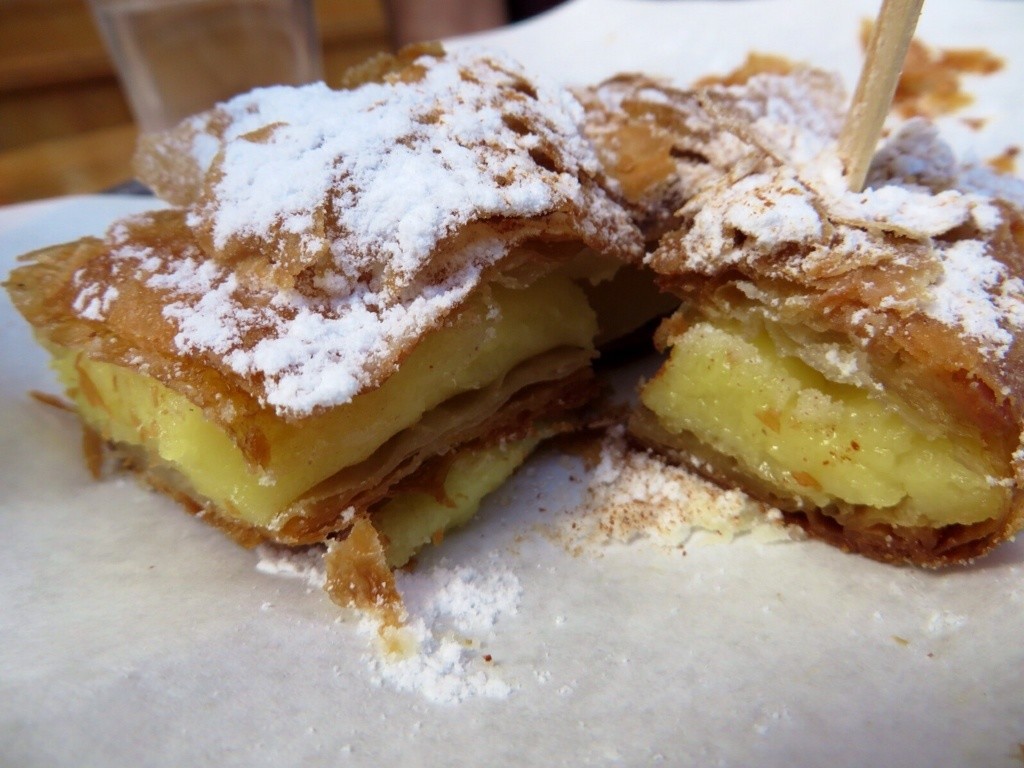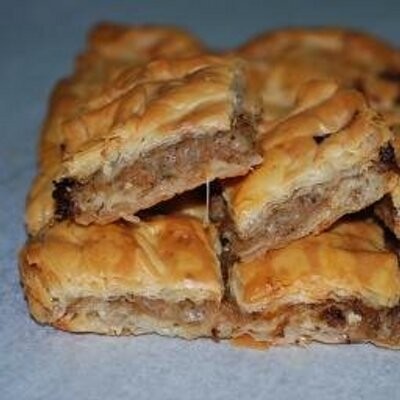Bougatsa

The perfect breakfast along with a bottle of cocoa! (Source)
In Thessaloniki the most famous breakfast pastry is "Bougatsa". You can find Bougatsa in every neighbourhood and in many variations. Bougatsa is orinally from Serres, a town in the Central Macedonia region in Northern Greece. Bougatsa is also popular in Veria and Halkidiki (Northern Greece) and in Chania and Iraklion which are in the island of Crete. But in Chania, it is not called just "bougatsa", it is called "bougatsa Chanion"(it means bougatsa from Chania) and is made by special pastry shops which are usually open from early morning until noon.
The most common filling is a sweet semolina custard. Common savory fillings include mizithra cheese or minced meat.

Bougatsa with cheese filling! (Source)

Bougatsa with minced meat filling. (Source)
Generally, the taste of bougatsa varies between regions of Greece. For example, bougatsa in Thessaloniki is crunchy, not very sweet and there are plenty of different fillings, while in Veria is very sweet and full of cream.
So, here is your chance to do it yourself at home!
The preparation time is almost one hour and you get twelve portions!
You will need the following ingredients:
- 270 gramms of granulated sugar
- four eggs and two egg yolks
- 400 grams of fresh milk
- 400 grams of heavy cream
- one teaspoon of vanilla extract
- one tablespoon of baking powder
- one package of phyllo dough
- 150 grams of butter
- some soft brown sugar, for sprinkling
- some caster sugar, for serving
- some ground cinnamon, for serving
And now we are ready to begin!
First, preheat the oven to 200 C.
Then we melt the butter in a small saucepan over medium heat. Using a pastry brush, brush a 30x35 cm baking pan with a lot of butter. Don't be afraid! Be generous with the butter.
Brush the sheet of phyllo dough with butter and place it in the pan. Then brush another sheet with butter and place it on top. Do not brush the rest of the phyllo dough sheets with butter. Drizzle some butter on to them, one at a time. Crumple each sheet, folding it like an accordion and transfer to the pan. Be careful not to press down on them so they do not flatten.
Continue in the same way, placing each folded sheet of phyllo dough gently next to the other, until all of the sheets of phyllo dough are in the pan.
Drizzle the leftover butter over the top of the folded phyllo dough in the pan.
Then, bake for twenty minutes or until the phyllo turns golden brown and crunchy.
TIP: to make sure that the phyllo become as crunchy as possible, place the baking pan on the highest rack level in the oven so the air is able to reach both top and bottom of the pan. This method of adding the phyllo sheets in the pan also allows the air to circulate between the phyllo, giving you the crunchiest result possible.
While the phyllo is getting all golden and crunchy, we can prepare the custard.
Start by beating the four eggs, the two egg yolks and the sugar in a bowl, using a hand whisk. Keep beating until the sugar is completely dissolved.
Then, add the vanilla, the baking powder, the milk and the heavy cream, similar to a creme anglaise.
When the sheets of phyllo dough are ready, remove them from the oven and turn the heat down to 180 C.
Pour the custard mixture over the phyllo.
Use a large measuring jug to make it easier and less messy!
Sprinkle some soft, brown sugar over the top (this will give the surface a sweet crunch).
Put the baking pan back to the oven and bake for twenty to twenty-five more minutes.
When it is ready, remove it from the oven and let it aside to cool for a bit.
Finally, sprinkle with lots of caster sugar and cinnamon.
Cut into pieces and serve.
Enjoy!

Enjoy your bougatsa with a lot of cinnamon and sugar powder! (Source)
Bougatsa fun fact number one:
The town of Serres achieved the record for the largest bougatsa on the 1st of June 2008. It weight 250 kilos, was 20 metres long and 60 centimetres thick. More than fourty bakers worked collectively to make it!
Bougatsa fun fact number two:
The process of hand preparation of the bougasta was featured in an episode of Anthony Bourdain: No Reservations, filmed in Greece.
Photo gallery
Want to have your own Erasmus blog?
If you are experiencing living abroad, you're an avid traveller or want to promote the city where you live... create your own blog and share your adventures!
I want to create my Erasmus blog! →



















Comments (0 comments)